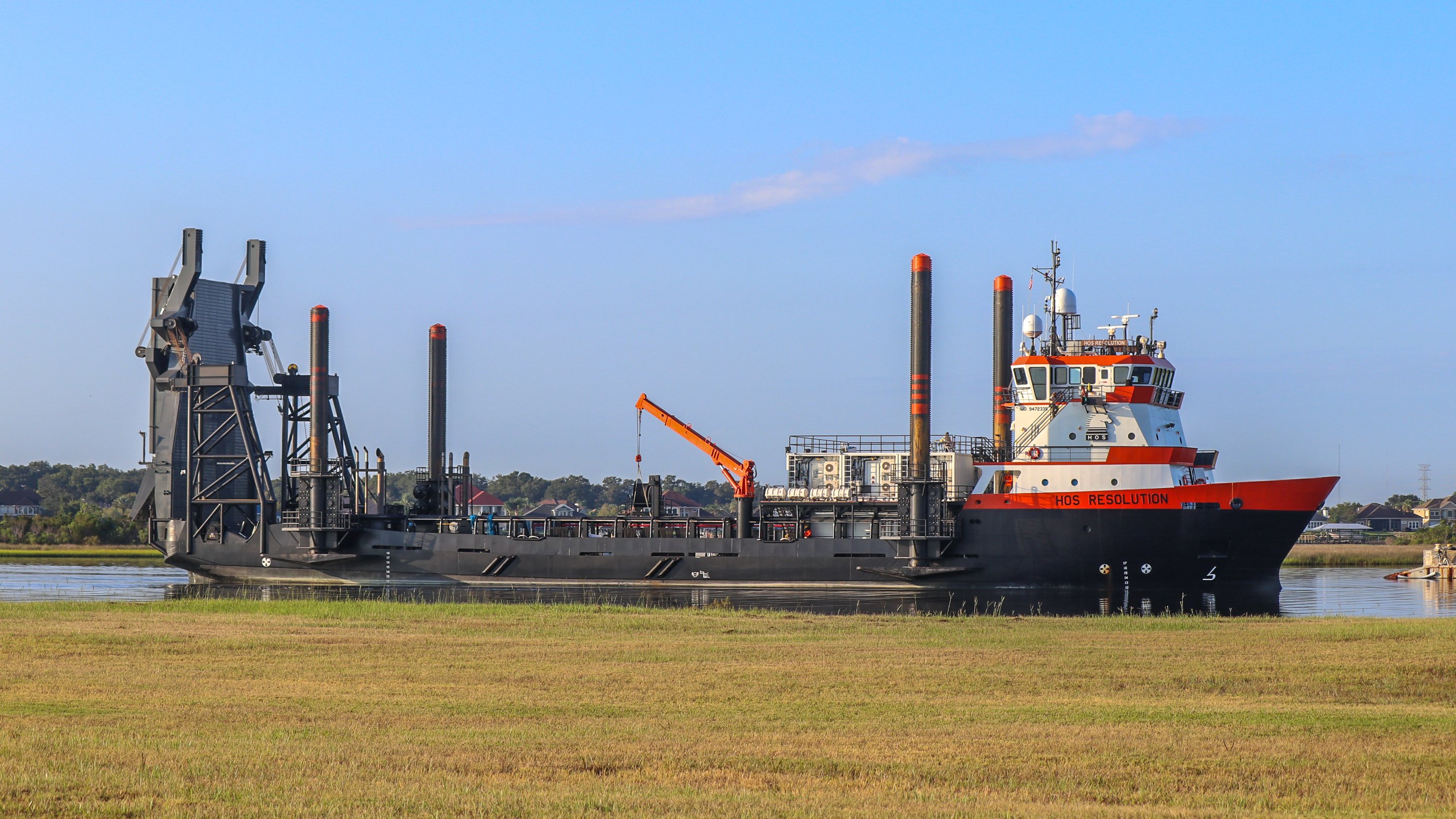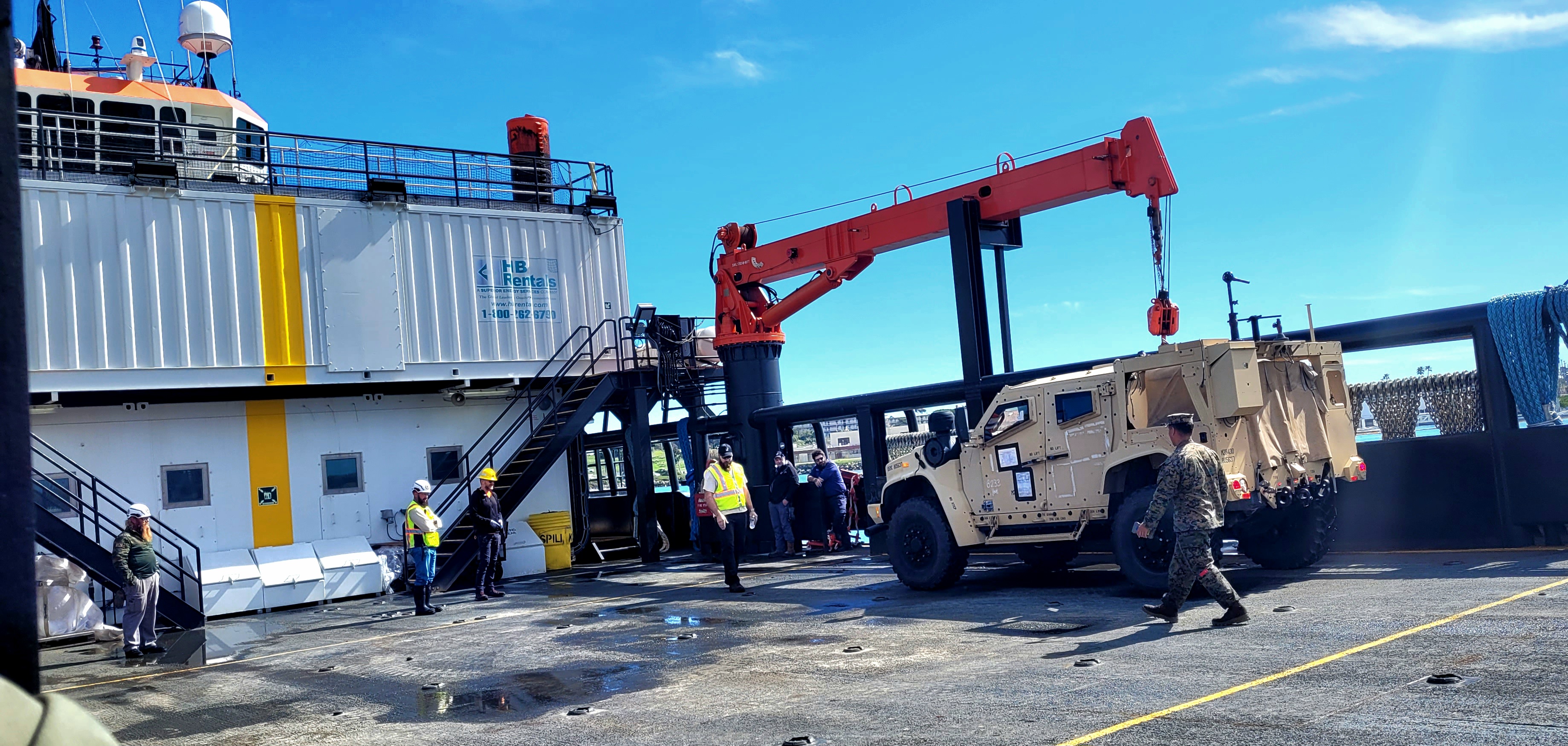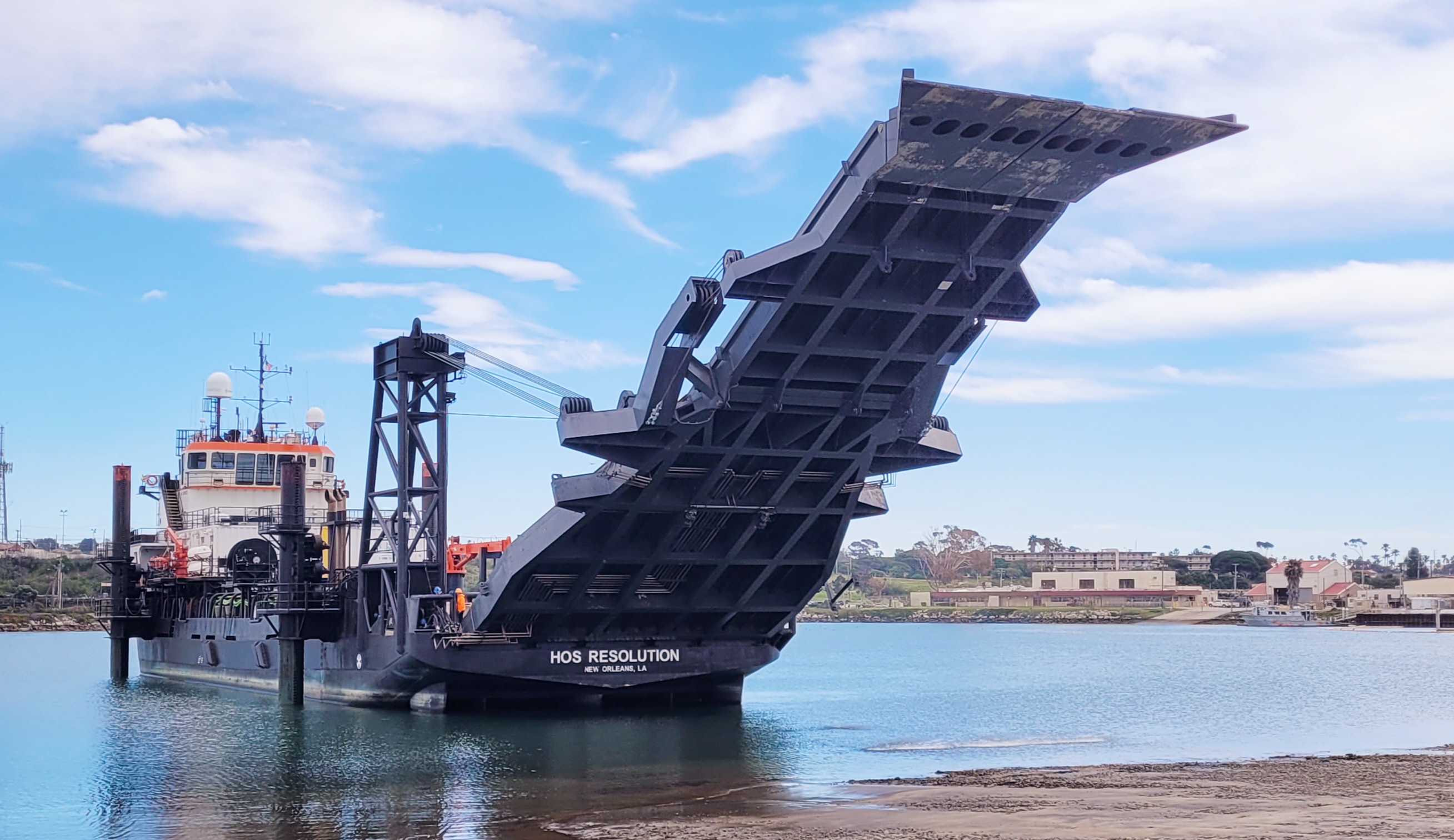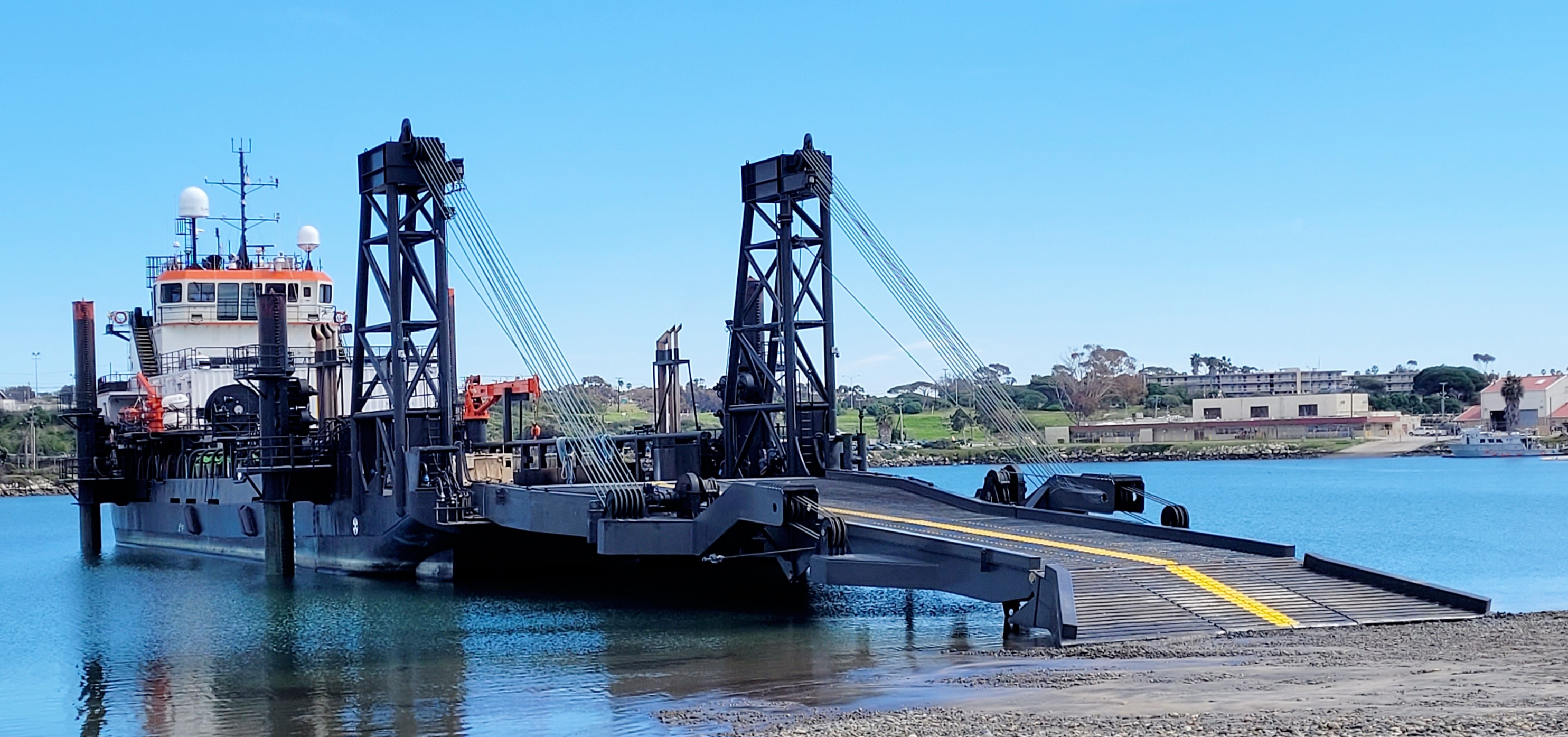
CAMP PENDLETON, Calif. – Gears grinded as offshore supply vessel Resolution folded its long stern ramp on Friday and prepared to head into the Pacific for an afternoon session with a group of Marines and their drones.
The 254-foot Resolution, under contract with the Marine Corps Warfighting Laboratory, pulled into Camp Pendleton’s Del Mar boat basin on Thursday to begin a series of experiments that the Marine Corps expects will help shape operational concepts and design for the Navy’s Landing Ship Medium. Resolution will also join the Army’s Project Convergence Capstone 3 experimentation that’s underway with the Marine Corps Tactical Systems Support Activity at Camp Pendleton.
The offshore support vessel is a stern landing vessel that’s a prototype for the future LSM, officials said, and it’s one of three planned contracted OSVs that will shape those decisions for the LSM as a platform in a contested logistics environment.

“This will teach us what we need to know to give the Navy the specifications that they need to build the medium landing ship,” Cathy Close, a Marine Corps Systems Command spokeswoman, said during a media briefing. “That’s the purpose of this, so we’re out here to learn, test it out, see how much it can hold, what it’s capacity [is], how many Marines can you put on it, how much gear, how many vehicles, what types of vehicles, can you fly things off of it, drones and anything like that.”
The OSV experimentation and future LSM, said Close, are helping MCWL get after ways to provide “mobility in the littorals – and not just in the Indo-Pacific.”
“We have to look for more innovative ways to move our stuff … and start looking more at creative, modern ways to move our supplies and equipment, because we’re more distributed in the Indo-Pacific than anywhere,” she added. Those Corps’ “stand-in forces” will be small, light, mobile and spread across a wider, contested area that challenges resupply and logistics, officials note.
Resolution is one of three OSVs the service wants to get to help round out its Force Design concepts, LSM design and tactics, techniques and procedures for how the Marine Littoral Regiments will use the ships. It also will support other MCWL experimentation, including testing with the Tactical Resupply Unmanned Aerial System, or TRUAS, a 150-pound drone-like unmanned aircraft.

The vessel is leased under a one-year contract, with potential to extend for additional years. “We’re going to get two more,” Close said. The vessel will head to Hawaii and then onto Japan, where it’s expected to support the 12th Marine Littoral Regiment and continue experimentation.
Built two decades ago, the New Orleans, La.,-based Resolution was modified in Louisiana and traveled to Marine Corps Support Facility Blount Island, S.C., and Mayport, Fla., for ship acceptance work before sailing through the Panama Canal for the experimentation off California.
Those modifications turned a ship built to support offshore oil facilities into a landing ship that can pull up onto a beach or drop its ramp on a rocky coast or quay wall and offload or embark personnel, vehicles, supplies and equipment. The modifications added a 115-foot-long ramp, four landing pylons and two “strong backs” towers to the ship that support the ramp, said Ray Butler, a contractor and member of the Demonstration Assistance Team based at Indian Head, Md.
The four thick, round pylons or “landing spuds” lower onto the coastal seafloor to provide stability for the ramp when it’s lowered onto a beach or coastal wall or rocks. Twin towers – one each at aft starboard and port – control the ramp and its cable system. The ramp is built in several sections – at 42 feet, 24 feet, and 44 feet wide each – that extend out and fold up. The end ramp section, or “flutters,” has four separate decks that can lift up or down to 14 degrees, enabling more stable loading onto an uneven beach or coastal terrain or quay wall, Butler said.
The vessel, which has a 54-foot beam and pulls a 12-foot draft, can cruise at 8 knots but can travel up to 14 knots, depending on tides and currents, he said. Resolution is crewed by 12 civilian mariners with Hornbeck Offshore Services. It has a 10-ton crane. A dozen vehicles can be stowed on the weather deck, which includes berthing and work space for embarked Marines.

The Marines’ planned experiments include UAS operations, tactical networks and military communications. The Resolution is a civilian ship with Coast Guard-regulated commercial communications, not military, Butler said, “so they bring that on with them. They establish inside the [ship’s] comm room.” A team of seven Marines were boarding the vessel for comms testing Friday, he said, and a few dozen Marines will embark in the coming days for UAS testing.
“The concept is wherever the Marines are at. The Marines come aboard, they do the tactical mission they need to do, they get off the ship and the ship goes back to pick up another unit or do another mission,” Butler said.
Several tests or limited technical assessments are planned next week, including participation in the Army’s PC-C4, a joint and multinational technology experiment in fires and sustainment that runs Feb. 23 to March 1 at Camp Pendleton and then at the Army’s National Training Center at Fort Irwin, Calif., through March 20.
“The experimentation we’re doing is based on contested logistics and maritime sustainment in a contested environment,” said Maj. Dan Greenlee, a maritime sustainment planner with MCWL. With the Force Design concept goals in mind, “this give[s] us an opportunity to do it in a real-world scenario, or closer to a real-world scenario, in an experimenting format.”
Tying in with the Army’s experimentation during PC-C4 will enable Marine-Army integration operations and watercraft control training for Army harbor masters, he said.
“It’s working out some of the muscle movements with what would be a joint scenario, if you were doing combined, joint logistics over the shore, CJLOTS. Potentially there is whatever watercraft or opportune lift is available is what a commander would use to move sustainment,” said Greenlee.
The future LSM, he added, “gives us intra-theater lift for [passengers] and equipment that you’re not going to get on an LCU-1600 [class] or a smaller vessel that doesn’t have the range or the seaworthy capability for long periods of time.”
MCWL is eager for feedback from Marines about employment considerations, manning and equipment limitations, he said. “What can we move, and how fast can we move it? What are our maintenance considerations for employing the vessel and putting military equipment on it?”
And during experimentation, he added, “there’s some other things to work out when it comes to a civilian captain working with a Marine and translating what is normal for us on the [military] side, not only terminology but just understanding how decisions are made from the commercial side. Because for that mariner, it’s his license we’re operating under.” The LSM, once it’s built and in the fleet, would be operated by the Navy, he said.

The vessel was a presence in the placid waters of Camp Pendleton’s boat basin, and on Friday morning drew its share of curiosity and official tours. One of those was Maj. Gen. Benjamin Watson, who commands the 1st Marine Division, which is headquartered at the base.
“It’s great to see it finally in action,” Watson said. “I think everyone is validating all the right things. This will give us the ability to refine kind of what we’re looking for in terms of the requirement and learn from it as we look towards the future LSM.”
This vessel is important to support Marines in an island-hopping campaign, as envisioned in a potential conflict with peer adversaries like China.
“That’s a lot of what we’re talking about, its ability to get close to the beach, a stable-enough platform and be able to carry enough to get a reasonable sized group of Marines shore-to-shore in a littoral environment,” he said. “It’s probably not the 100 percent solution, but it’s certainly an 80, 90 percent solution for what we need.”





